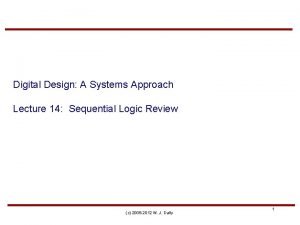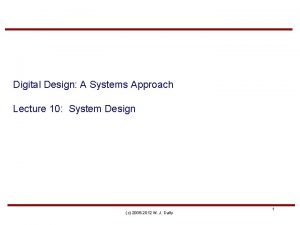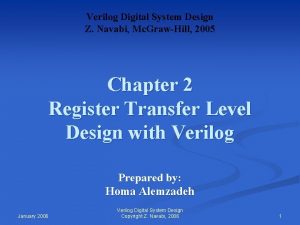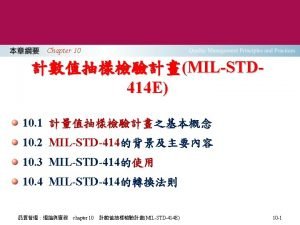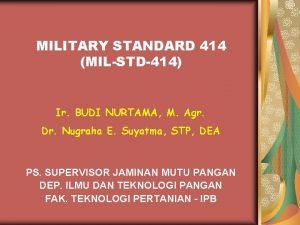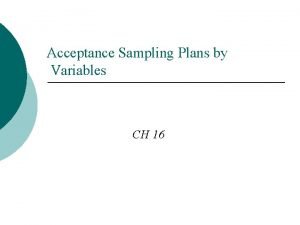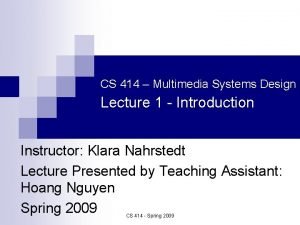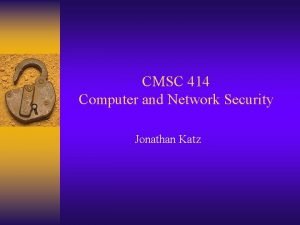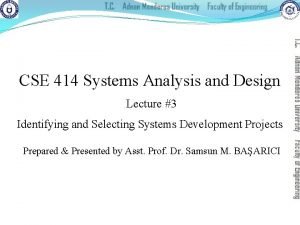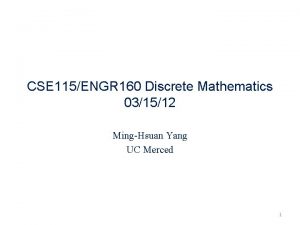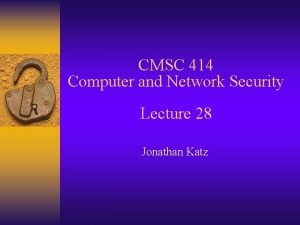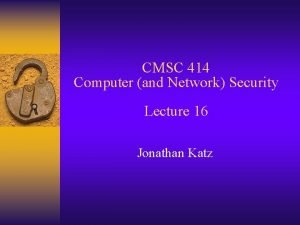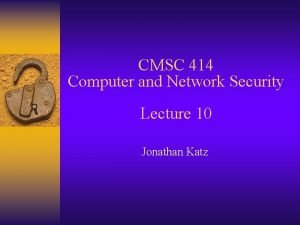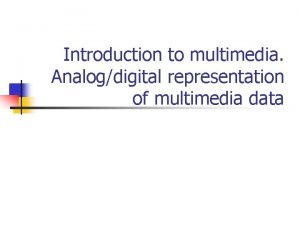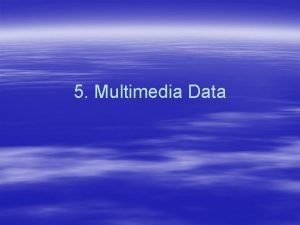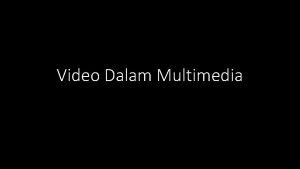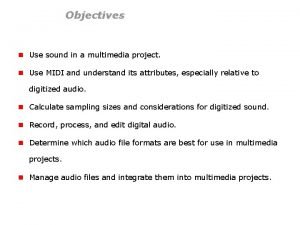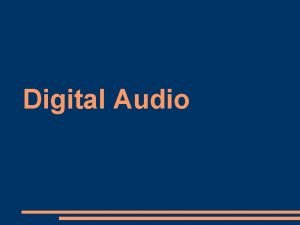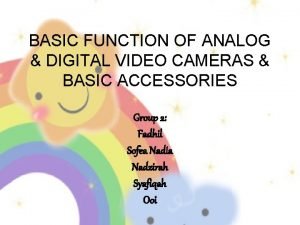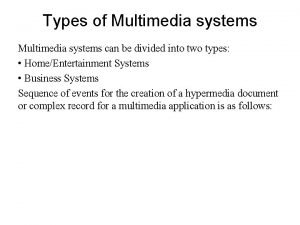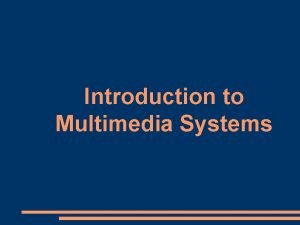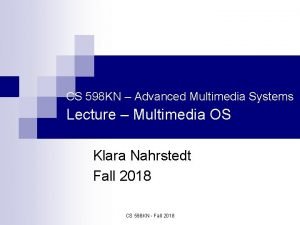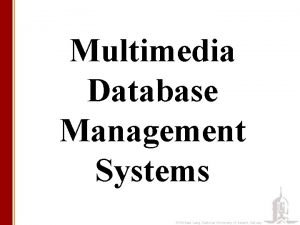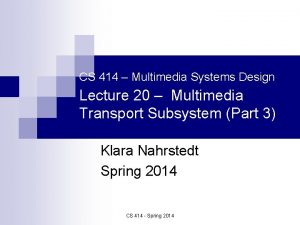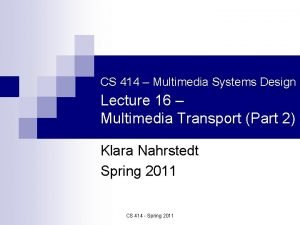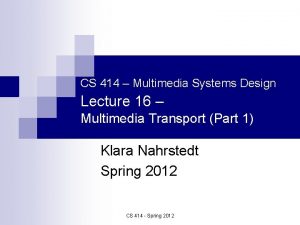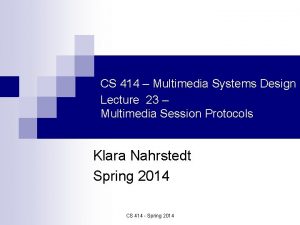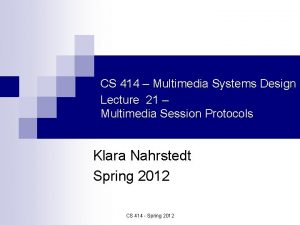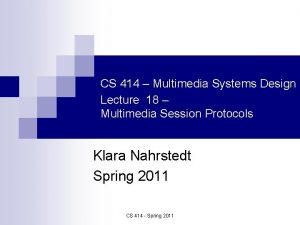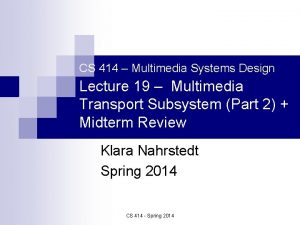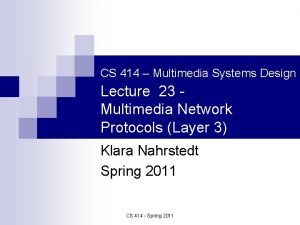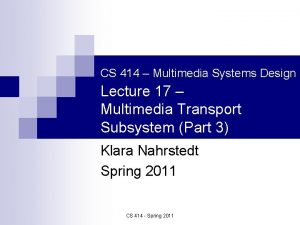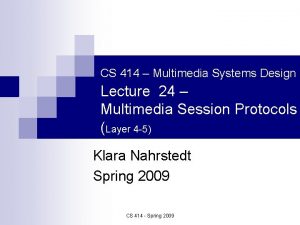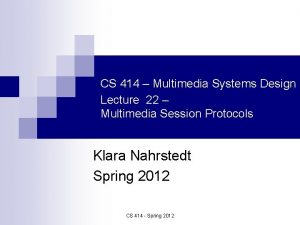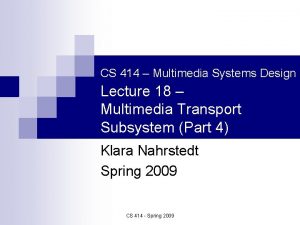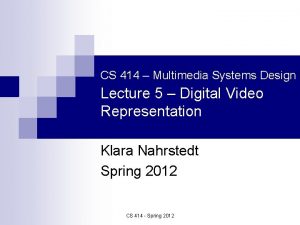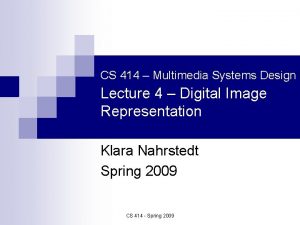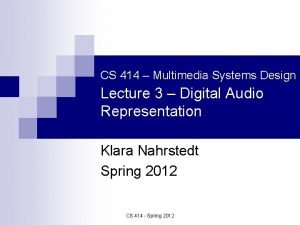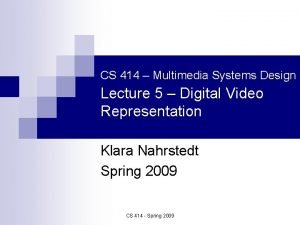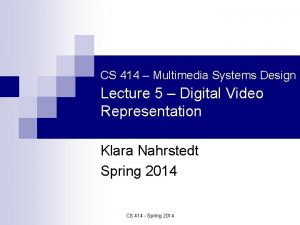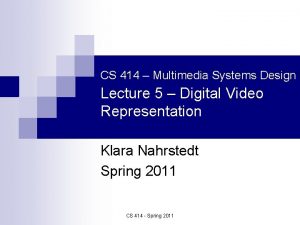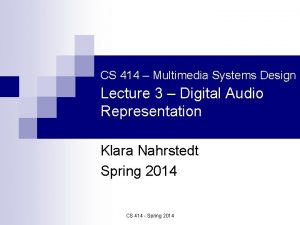CS 414 Multimedia Systems Design Lecture 6 Digital




































- Slides: 36

CS 414 – Multimedia Systems Design Lecture 6 – Digital Video and Introduction to Compression Klara Nahrstedt Spring 2014 CS 414 - Spring 2014

Administrative MP 1 is posted n See Class website and compass n MP 1 lecture will be on February 7 (Friday) in class. Please, read the MP 1 before attending the class n CS 414 - Spring 2014

Today Introduced Concepts Analog and Digital Television n Need for compression and compression algorithms classification n Basic Coding Concepts n ¨ Fixed-length coding and variable-length coding ¨ Compression Ratio ¨ Entropy CS 414 - Spring 2014

Television History (Analog) n 1927, Hoover made a speech in Washington while viewers in NY could see, hear him n AT&T Bell Labs had the first “television” ¨ 18 fps, 2 x 3 inch screen, 2500 pixels

Analog Television Concepts n n n Production (capture) ¨ 2 D ¨ structured formats Representation and Transmission ¨ popular formats include NTSC, PAL, SECAM Re-construction ¨ scanning ¨ display issues (refresh rates, temporal resolution) ¨ relies on principles of human visual system CS 414 - Spring 2014

Color Space: YUV n PAL video standard ¨Y is luminance ¨ UV are chrominance n Y YUV from RGB Y =. 299 R +. 587 G +. 114 B U = 0. 492 (B - Y) V = 0. 877 (R - Y) U-V plane at Y=0. 5 U V CS 414 - Spring 2014 Source: wikipedia

YIQ (NTSC) n YIQ from RGB Y =. 299 R +. 587 G +. 114 B I =. 74 (R - Y) -. 27 (B - Y) Q = 0. 48 (R - Y) + 0. 41 (B Y) CS 414 - Spring 2014 YIQ with Y=0. 5 Source: wikipedia

Video Representations CS 414 - Spring 2014

TV History CS 414 - Spring 2014

HDTV (Digital) n Resolutions: ¨ 1920 x 1080 (1080 p) – Standard HD (HDTV) ¨ 2160 p, … ¨ 4096 x 2304 (4096 p) – 4 K High HD n Frame rate: ¨ HDTV - 50 or 60 frames per second ¨ HDTV – 120 fps CS 414 - Spring 2014

HDTV n Interlaced (i) and/or progressive (p) formats ¨ Conventional TVs – use interlaced formats ¨ Computer displays (LCDs) – use progressive scanning MPEG-2 compressed streams n In Europe (Germany) – MPEG-4 compressed streams n CS 414 - Spring 2014

Aspect Ratio and Refresh Rate n Aspect ratio Conventional TV is 4: 3 (1. 33) ¨ HDTV is 16: 9 (2. 11) ¨ Cinema uses 1. 85: 1 or 2. 35: 1 ¨ n Frame Rate ¨ NTSC is 60 Hz interlaced (actually 59. 94 Hz) ¨ PAL/SECAM is 50 Hz interlaced ¨ Cinema is 24 Hz noninterlaced CS 414 - Spring 2014 Source: wikipedia

Digital Video and TV n n Bit rate: amount of information stored per unit time (second) of a recording Color Coding: YCr. Cb of YUV that scales and shifts the chrominance values into range 0. . 1 Y ¨ Subset Y = 0. 299 R + 0. 587 G +. 114 B Cr = ((B-Y)/2) + 0. 5 Cb = ((R-Y)/1. 6) + 0. 5 CS 414 - Spring 2014 Cr Cb

Digital Video and TV n Color space compression ¨ YUV 444 n 24 bits per pixel ¨ YUV 422 n 16 bits/pixel ¨ YUV 411 n 12 bits/pixel CS 414 - Spring 2014

Digital Video and TV n DVD video ¨ Since 1997 ¨ Resolution and frame rate 704 x 480 at 29. 97 fps n 704 x 576 at 25 fps n ¨ Bitrate: 9. 8 Mbps CS 414 - Spring 2014

Digital Video and TV n Blu-ray video since 2006 ¨ Resolution and frame rate ¨ 1920 i (@59. 94 fps) – interlaced n 1920 p (@24 fps) – progressive n …. n ¨ Bitrate : 40 Mbps CS 414 - Spring 2014

3 DTV Refresh rate no less than 120 Hz n Synchronized shutter glasses to enable different views for different eyes n CS 414 - Spring 2014

Today Introduced Concepts Analog and Digital Television n Need for compression and compression algorithms classification n Basic Coding Concepts n ¨ Fixed-length coding and variable-length coding ¨ Compression Ratio ¨ Entropy CS 414 - Spring 2014

Reading n Media Coding and Content Processing, Steinmetz, Nahrstedt, Prentice Hall, 2002 ¨ Data n Compression – chapter 7 Basic coding concepts – Sections 7. 1 -7. 4 and lecture notes CS 414 - Spring 2014

Integrating Aspects of Multimedia Image/Video Capture Audio/Video Perception/ Playback Audio/Video Presentation Playback Image/Video Information Representation Transmission Audio Capture Transmission Compression Processing Audio Information Representation Media Server Storage CS 414 - Spring 2014 A/V Playback

Need for Compression n Uncompressed audio 8 KHz, 8 bit n 8 K per second ¨ 30 M per hour ¨ n 7. 37 Mbytes per second ¨ 26. 5 Gbytes per hour ¨ 44. 1 KHz, 16 bit n 88. 2 K per second ¨ 317. 5 M per hour ¨ n Uncompressed video 640 x 480 resolution, 8 bit color, 24 fps 640 x 480 resolution, 24 bit (3 bytes) color, 30 fps 27. 6 Mbytes per second ¨ 99. 5 Gbytes per hour ¨ 100 Gbyte disk holds 315 hours of CD quality music n 100 Gbyte disk holds 1 hour of high quality video CS 414 - Spring 2014

Broad Classification n Entropy Coding (statistical) ¨ lossless; independent of data characteristics ¨ e. g. RLE, Huffman, LZW, Arithmetic coding n Source Coding ¨ lossy; may consider semantics of the data ¨ depends on characteristics of the data ¨ e. g. DCT, DPCM, ADPCM, color model transform n Hybrid Coding (used by most multimedia systems) ¨ combine entropy with source encoding ¨ e. g. , JPEG-2000, H. 264, MPEG-2, MPEG-4, MPEG-7 CS 414 - Spring 2014

Data Compression n Branch of information theory ¨ minimize amount of information to be transmitted n Transform a sequence of characters into a new string of bits ¨ same information content ¨ length as short as possible CS 414 - Spring 2014

Concepts n Coding (the code) maps source messages from alphabet (A) into code words (B) n Source message (symbol) is basic unit into which a string is partitioned ¨ can n be a single letter or a string of letters EXAMPLE: aa bbb cccc ddddd eeeeee fffffffgggg ¨ A = {a, b, c, d, e, f, g, space} ¨B = {0, 1} CS 414 - Spring 2014

Today Introduced Concepts Analog and Digital Television n Need for compression and compression algorithms classification n Basic Coding Concepts n ¨ Fixed-length coding and variable-length coding ¨ Compression Ratio ¨ Entropy CS 414 - Spring 2014

Taxonomy of Codes n Block-block ¨ source msgs and code words of fixed length; e. g. , ASCII n Block-variable ¨ source message fixed, code words variable; e. g. , Huffman coding n Variable-block ¨ source n variable, code word fixed; e. g. , RLE Variable-variable ¨ source variable, code words variable; e. g. , Arithmetic CS 414 - Spring 2014

Example of Block-Block n n Coding “aa bbb cccc ddddd eeeeee fffffffgggg” Requires 120 bits Symbol Code word a 000 b 001 c 010 d 011 e 100 f 101 g 110 space 111

Example of Variable-Variable n n Coding “aa bbb cccc ddddd eeeeee fffffffgggg” Requires 30 bits ¨ don’t forget the spaces Symbol Code word aa 0 bbb 1 cccc 10 ddddd 11 eeeeee 100 fffffff 101 gggg 110 space 111

Concepts (cont. ) n A code is ¨ distinct if each code word can be distinguished from every other (mapping is one-to-one) ¨ uniquely decodable if every code word is identifiable when immersed in a sequence of code words n e. g. , with previous table, message 11 could be defined as either ddddd or bbbbbb CS 414 - Spring 2014

Static Codes n Mapping is fixed before transmission ¨ message represented by same codeword every time it appears in message (ensemble) ¨ Huffman coding is an example n Better for independent sequences ¨ probabilities of symbol occurrences must be known in advance; CS 414 - Spring 2014

Dynamic Codes n Mapping changes over time ¨ also n referred to as adaptive coding Attempts to exploit locality of reference ¨ periodic, frequent occurrences of messages ¨ dynamic Huffman is an example n Hybrids? ¨ build set of codes, select based on input CS 414 - Spring 2014

Traditional Evaluation Criteria n Algorithm complexity ¨ running n time Amount of compression ¨ redundancy ¨ compression n ratio How to measure? CS 414 - Spring 2014

Measure of Information Consider symbols si and the probability of occurrence of each symbol p(si) n In case of fixed-length coding , smallest number of bits per symbol needed is n L ≥ log 2(N) bits per symbol ¨ Example: Message with 5 symbols need 3 bits (L ≥ log 25) ¨ CS 414 - Spring 2014

Variable-Length Coding. Entropy What is the minimum number of bits per symbol? n Answer: Shannon’s result – theoretical minimum average number of bits per code word is known as Entropy (H) n CS 414 - Spring 2014

Entropy Example n Alphabet = {A, B} ¨ p(A) n = 0. 4; p(B) = 0. 6 Compute Entropy (H) ¨ -0. 4*log 2 0. 4 + -0. 6*log 2 0. 6 =. 97 bits CS 414 - Spring 2014

Summary n Symmetric compression ¨ requires same time for encoding and decoding ¨ used for live mode applications (teleconference) n Asymmetric compression ¨ performed once when enough time is available ¨ decompression performed frequently, must be fast ¨ used for retrieval mode applications (e. g. , an interactive CD-ROM) CS 414 - Spring 2014
 01:640:244 lecture notes - lecture 15: plat, idah, farad
01:640:244 lecture notes - lecture 15: plat, idah, farad Digital systems testing and testable design
Digital systems testing and testable design Digital design: a systems approach
Digital design: a systems approach Digital design a system approach
Digital design a system approach Digital systems design using verilog
Digital systems design using verilog Multimedia becomes interactive multimedia when
Multimedia becomes interactive multimedia when Examples of non linear multimedia
Examples of non linear multimedia Linear and nonlinear multimedia
Linear and nonlinear multimedia Esa multimedia.esa.int./multimedia/virtual-tour-iss
Esa multimedia.esa.int./multimedia/virtual-tour-iss 0 414
0 414 Tabel military standard
Tabel military standard Mil std 414
Mil std 414 Pc 414
Pc 414 Cs 414
Cs 414 Cmsc414 umd
Cmsc414 umd Cse 414
Cse 414 Gcd of 414 and 662
Gcd of 414 and 662 Cmsc 414
Cmsc 414 Cmsc 414
Cmsc 414 Cmsc 414
Cmsc 414 Advanced operating system notes
Advanced operating system notes Articulators
Articulators Lecture sound systems
Lecture sound systems Justin sconza
Justin sconza Analog and digital video
Analog and digital video Multimedia data
Multimedia data Pengertian video conferencing
Pengertian video conferencing Sound in multimedia
Sound in multimedia Digital audio in multimedia
Digital audio in multimedia Analog vs digital video
Analog vs digital video Categories of multimedia systems
Categories of multimedia systems Characteristics of multimedia
Characteristics of multimedia Cs598
Cs598 Mmdbms supports
Mmdbms supports Eurocode lap lengths
Eurocode lap lengths Urban design lecture
Urban design lecture Principles of design in interior design ppt
Principles of design in interior design ppt


